Getting the Right Exposure
The central part of the focusing screen should always be aimed at the main subject
when centering the needle. Otherwise unimportant bright or dark areas may have adverse
influence on the exposure reading. If an off-center composition is desired, first
measure the light striking the main subject and set the aperture and shutter speed
to center the needle. Then move the camera until the desired composition appears
in the viewfinder.
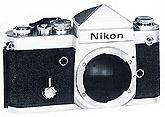 |
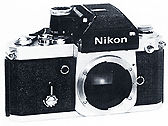 |
For subjects of uniform brightness, a reading may be taken from any part of the subject. However, if the lighting is harsh or contrasty, move up close and measure the light failing on the most important part of the subject in which detail is desired in the final picture. |
An visual comparison between
a eye level meterless prism DE-1 with the Photomic Finder DP1.
If the picture includes an unusually bright source of light such as a light bulb
or expanse of sky, move the camera so that the light source does not dominate the
viewfinder while You make your reading. For backlighted subjects,move up close and
include dark areas of the subject in your reading.
Keep out stray light
The finder is designed to minimize the effect of light entering through the finder
eyepiece under normal conditions. However, in the following situations, the use of
a finder eyecup is recommended to insure complete exclusion of stray light: •
When the camera is in sunlight and the subject is in shade.
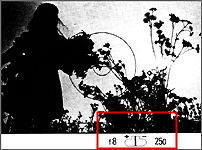 |
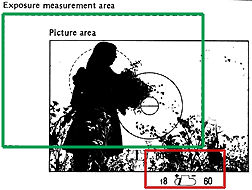 |
| Measuring the bright area in the center of the screen will cause underexposure of the main subject. | For correct exposure, first measure the light striking the main subject, then compose and shoot. |
• When the stop-down method is used at small apertures.
• When a shaft of sunlight falls between the eye and the eyepiece.
When the needle on top of the finder is used to determine exposure, the eyepiece should be covered with the hand to prevent extraneous light from entering the finder.
EXPOSURE
MEASUREMENT: SPECIAL CASE
Stop-Down Exposure Measurement
With the following lenses and accessories, full-aperture exposure measurement is not possible, either because the lens has no auto-diaphragm or because the diaphragm will not couple with the meter. Therefore, the stop-down method must be used.
 |
This means measuring exposure with the lens aperture diaphragm stopped down to the taking aperture. |
First, push the coupling
pin up into the Photomic finder with a coin or similar object so that the f/5.6 appears
in the maximum aperture indicator window. Mount the lens or lens/ accessory setup
on the camera and switch on the meter in the usual way.
Bellows Focusing Attachments, Extension Rings and Focusing Unit To determine
exposure, select the desired shutter speed and stop down the lens manually until
the needle centers.
Preset Lenses Use the same procedure as above for lenses having preset diaphragms,
such as the PC-Nikkor 35mm f/2.8.
Auto Lenses Without Coupling Prong Some lenses like the Zoom-Nikkor Auto 200-600mm
f/9.5 have an auto diaphragm but no coupling prong. Use the depth-of-field preview
button to stop down the lens until the needle is centered.
Reflex-Nikkor Lenses The Reflex-Nikkor 500mm f/8, 1 000mm f/I I and 2000mm
f/l I lenses have no aperture diaphragm. Adjust the shutter speed until the needle
is centered.
Note: Since focusing may be difficult
or impossible at small apertures due to image darkening on the screen, first open
the lens to full aperture to focus. Then determine the correct exposure by the stop-down
method.
Exposure Correction for Special Lens-Focusing Screen Combinations
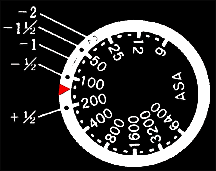 |
Because the light-transmitting properties of some focusing screens differ from those of ordinary screens, certain lens screen combinations require exposure correction to compensate for the influence of the screen. The numbers in the table on the opposite page show the exposure corrections in f-stops. With the Photomic finder, the method used is to set the film speed (ASA) against the proper compensating mark engraved on the film speed index ring. |
For example, the table indicates a half-stop decrease (-1/2) for the Fisheye Nikkor Auto 8mm f/2.8 lens with type C screen. If the film speed is ASA 100, lift up the Index ring and set the number 100 on the film speed dial opposite the -1/2 mark. When no exposure correction (0) is Indicated, the ASA rating for the film in use should be opposite the red arrow.
Repro-Copying, Slide-Copying and Photornicrography
Some exposure correction may be necessary depending on the type of film and the subject or the original slide. The numbers in the tables below show the exposure correction in f-stops. Readjust either the shutter speed or the lens diaphragm according to the indicated numbers, or reset the film speed. 3 marks on the film-speed scale are equivalent to one f-stop. If the table Indicates a one-stop increase with a film rated at ASA 100, reset the red arrow opposite the number 50.
|
Original/Type of Film |
Repro/Slide Copying |
|||
|
B/W/Color |
Letters/Figures on Light Background |
Letters/Figures on Dark Background |
Photomicrography |
|
|
Panchromatic Film for general use |
No Compensation required |
+ 1-1/2 Stop |
- 1/2 Stop |
+ 1 Stop |
Viewfinder Ready light
The Photomic finder has a built-in ready-light at the eyepiece for use with some of the older version of Nikon Speedlight units *. The lamp lights up to let you know when the Speedlight is fully charged and ready to fire without removing your eye from the viewfinder. It goes out after the speed light has fired. The ready-light is connected to the speed light by means of an optional ready light adapter. For details, see the speed light instruction
* Warning: Most modern Nikon Speedlight has a standard
ISO mounting foot, while Nikon F2 series cameras has a dedicated proprietary accessory
shoe. To use such flash units on a Nikon F2 you have to use a Flash Coupler in order
to use such flash with a Nikon F2 camera; while in most cases, flash ready light
may not be readily available)
Care and Maintenance:
Although like the camera itself, a Photomic finder is also ruggedly constructed.
However, it deserves the same care you would give any precision instrument. However,
make note that the Photomic Finder is not supported even by Nikon factory anymore
and any mishap would require you to search for third party servicing and thus - follow
the simple precautions given below and the Photomic should give years of extended
service.
• Store the finder in a case to
keep out dust. Avoid storing it In places liable to excessive heat, cold or dampness.
• Attach a prism guard when storing
the finder separately.
• To insure most dependable service,
clean the battery con - tact surfaces periodically with a rough cloth.
• Avoid fingerprints and dust particles
on the prism surface.
• Brush away grit or dust with a
soft brush or use a rubber
syringe. Do not use cloth or ordinary tissue.
• If smudges or finger marks persist,
use tissue with a professionally recommended lens cleaner very sparingly. Wipe with
a circular motion and gentle pressure. Even an approved cleaner can cause damage
if it seeps into the prism mount.
• To insure that the exposure meter
will operate properly when needed, it should be checked periodically. Make a few
trial exposures before leaving for a holiday or a important shooting assignment.
Specifications and Features:
Film speed scale: ASA 6-6400
Metering range: EV 1-17 at ASA 100 (1 sec. at f/1.4-1/2000 sec. at f/8 with
50mm f/1.4 lens)
Light measuring method: Center-weighted, full-aperture measurement via a pair
of Cds metering cells
Aperture coupling range: f/1.2-f/32, aperture selected visible In viewfinder
Shutter speed coupling range: 1-1/2000 sec. plus B. Shutter speed visible
in viewfinder
Maximum aperture scale range: f/1.2-f/5.6
Meter needle: Visible In the viewfinder and In the window on top of the prism
housing
Meter switch: Camera film-advance lever switches meter on and off
Battery check: Provided
Batteries: 2 silver batteries (1.5V each)
Weight: 220g
 |
The soft rubber finder eyecup screws directly onto the finder eyepiece to Prevent extraneous light from entering the viewfinder. When using an eyepiece correction lens with a finder eyecup, it is recommended to use the Nikkormat type eyecup. First, fit the lens into the eyecup in advance. Then screw the assembly onto the finder eyepiece. |
Eyepiece Correction Lenses
 |
The nine eyepiece correction lenses are designed to permit nearsighted and farsighted users to view and focus without their glasses. Available in -2, -3, -4, -5, 0, +0.5, +1, +2 and +3 diopters, each representing the combined dioptre of the lens and the finder. Simply screw into the finder eyepiece. |
| Previous | 2/2 More info, features and Specifications
| Back | Main Index Page - Interchangeable Viewfinders
System
Accessories:
Motor
Drives
/ Prisms / Screens / Macro / Film
Backs
/ Flash
Other Accessories:
DS-1 / DS-2 / DS-12 / eyepiece / DH-1 / cases / Cable releases / Miscellaneous
| History
& Background
| Semi-FAQ | Various Features and Functions - 6 Parts |
| Message Board | for
your favourite Nikon
F2 Series SLR model(s)
| Message Board | for your Nikon Optics in a shared environment
| Message Board | Specifically for Dispose or Looking for Nikon/Nikkor Photographic
Equipment
| Back | to Main Index Page of Nikon F2 Series SLR models
| Back |
Main Index Page of Pictorial History of Nikon SLRs
 |
The Eyes of Nikon:- |
Fisheye-Nikkor Lenses - Circular | Full Frame | Ultrawides Lenses - 13mm15mm18mm20mm | Wideangle Lenses - 24mm28mm35mm |
Standard Lenses - 45mm 50mm 58mm | Telephoto Lenses - 85mm105mm135mm180mm & 200mm |
Super-Telephoto Lenses - 300mm 400mm 500mm 600mm 800mm 1200mm |
Special Application lenses:
Micro-Nikkor Lenses - 50mm~55mm -60mm 85mm -105mm 200mm Micro-Zoom 70-180mm
Perspective Control (PC) - 28mm 35mm PC-Micro 85mm
Dedicated Lenses for Nikon F3AF: AF 80mm f/2.8 | AF 200mm f/3.5 EDIF
Depth of Field Control (DC): 105mm 135mm
Medical Nikkor: 120mm 200mm
Reflex-Nikkor Lenses - 500mm 1000mm 2000mm
Others: Noct Nikkor | OP-Nikkor | UV Nikkor 55mm 105mm | Focusing Units | Bellows-Nikkor 105mm 135mm
Nikon Series E Lenses: 28mm35mm50mm100mm135mm | E-Series Zoom lenses: 36~72mm75~150mm70~210mm
MF Zoom-Nikkor Lenses: 25~50mm | 28~45mm | 28~50mm | 28~85mm | 35~70mm | 36~72mm E | 35~85mm | 35~105mm | 35~135mm |
35~200mm | 43~86mm | 50~135mm | 50~300mm | 70~210mm E | 75~150mm E | 80~200mm | 85~250mm |
100~300mm | 180~600mm | 200~400mm | 200~600mm | 360~1200mm | 1200~1700mm
Tele-Converters: TC-1 | TC-2 | TC-200 | TC-201 | TC-300 | TC-301 | TC-14 | TC-14A | TC-14B | TC-14C | TC-14E | TC-16 | TC-16A | TC-20E
![]()
Nikon F
| Nikon F2 |
Nikon
F3
| Nikon F4 |
Nikon
F5
| Nikon F6 |
Nikkormat / Nikomat |
Nikon FM
| Nikon FE/ FA | Nikon EM/FG/FG20 | Nikon Digital SLRs | Nikon - Other models
MIR Supports for Photographic Community: Various Message Boards/Community
Forums
Nikon
F-series|
Nikon
F2-series|
Nikon
F3-series|
Nikon F4-series| Nikon
F5-series|Nikkormat/Nikomat-series
Nikon FM-series|Nikon
FE-series|Nikon
FA|Nikon
Digital
SLR
series|Various
Nikon
Models|Nikkor
Optic
-shared
Others:- Free Trade Zone - Photography| Free Trade Zone - Business Community |Free To Zouk - Photographic Community
Apple's Mac Public Community Message Board | Windows based PC &
Apple/Mac
Public Community Trade Exchange Centre
Recommended links to understand
more technical details related to the Nikkor F-mount and production Serial Number:
http://rick_oleson.tripod.com/index-153.html by: my friend, Rick Oleson
http://www.zi.ku.dk/personal/lhhansen/photo/fmount.htm by: Hansen, Lars Holst
http://www.mir.com.my/rb/photography/hardwares/nikonfmount/lens2.htm
http://www.photosynthesis.co.nz/nikon/serialno.html
About this photographic site.
HOME - Photography in Malaysia |
Copyright © 2000. leofoo ®. MIR Web Development Team.
In
memory of my friend Com.
Augusto Staut,
Brazil, 1971-2000.
Credit: Chuck Hester, US for his patience, encouragement
and help to setup the various content in this site; Robert Johnson for some of his original
images on the F2H-MD appeared in this site; my ex-staff, KiaSu for his superb
3-D logo appeared in this Nikon F2 site; Marc Vorgers from Holland who
generously provide me with some of his images of F2AS; MCLau®, who has so much time with me to
re-edit the content in this site and not to mention buying a Nikon Coolpix 990 just
for this site. Keat Photo,
Kuala Lumpur for providing
their Nikon F2A to take some images for this site; again, Mr Edward Ngoh the
great camera collector who provides us his collection of F2AS with MD-2; hawkeye.photographic.com
for their images on the Speed Magny film backs; Sean Cranor for his image
on Nikon F2 25th Anniversary Model; Ted Wengelaar®, Holland for his continuous
flow of input on some of the early Nikon bodies; CYLeow ® , photo editor of the Star
newspaper, Malaysia for some of his images used in this site. Ms Rissa Chan, Sales manager from
Shriro Malaysia who has helped to provide some of the very useful input. HiuraShinsaku®,
Nikomat ML, Japan for some of his images on various F2 models; my staff, Wati, Maisa, Mai and my nephew, EEWyn®, who volunteered and helping me
did so many of the film scanning works. Contributing photographers or resellers:
Jen Siow, Foo KokKin, Arthur Teng, Mark Fallander, John
Ishii, Ed Hassel, YoonKi Kim, Jean-Louis, M.Dugentas (Dell Corner.com.), Mr "Arsenall" and a few images mailed
in from surfers with no appropriate reference to their origin. Dedicated to KU Yeo, just to express our mutual regrets over the outcome of
a recent corporate event. Made with a PowerMac, broadcast with a Redhat Linux powered server.
![]()
![]()